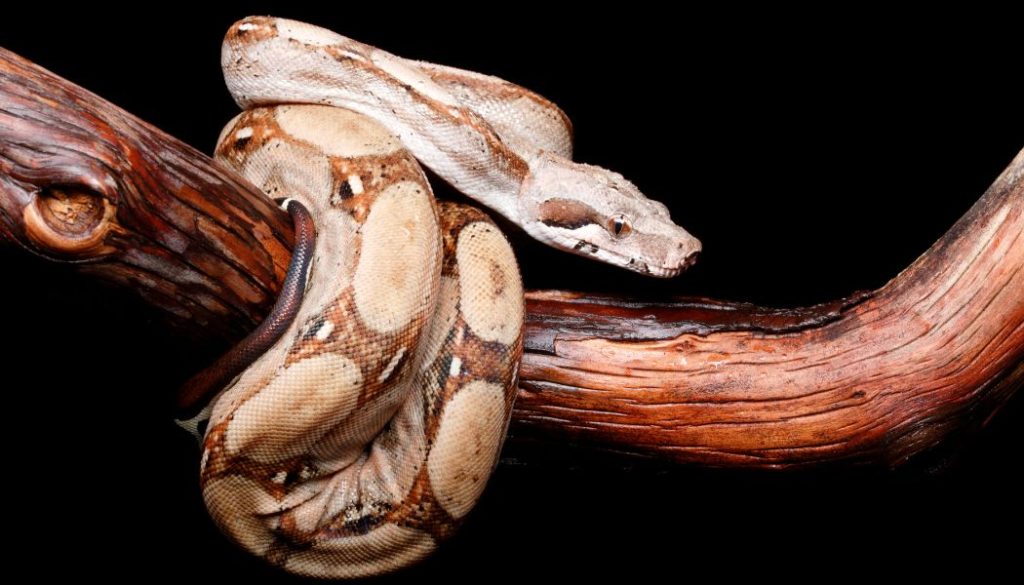Red tail boas aren’t strictly nocturnal. In fact, they’re more accurately described as “crepuscular,” meaning they’re most active during the low-light conditions of dawn and dusk. Their activity patterns can vary depending on factors like temperature, environment, and whether they’re in the wild or in captivity.
In hotter climates, they might opt for nighttime activity to avoid the heat.
But if you’re thinking of them as solely night creatures, you’d be missing out on their adaptability and intriguing behavior. They’re more flexible than you might think!
This article dives deep into the fascinating world of red tail boas to explore their activity patterns in the wild and in captivity.
We’ll dig into what “nocturnal” really means, how light cycles impact these incredible creatures, and even debunk some myths along the way.
From their feeding habits to that mysterious term “crepuscular,” we’re covering all the bases. Get ready to unravel the enigma that is the red tail boa!

Table of Contents
Breaking Down the Term “Nocturnal”
Hey there, snake enthusiasts and curious minds alike! We’ve all heard the term “nocturnal” thrown around, but what does it actually mean?
In the animal kingdom, being nocturnal means that you’re most active during the nighttime, usually when the sun has gone down and most of us are snuggled up in bed. Think owls, raccoons, and some bats; these creatures thrive when the moon is out.
But why is it important to know if an animal, particularly a red tail boa, is nocturnal or not? Well, if you’re a pet owner or a wildlife researcher, understanding an animal’s activity pattern can be a game-changer.
Knowing when they eat, sleep, or go out hunting can help in providing better care or in scientific observation. So, it’s not just a random trivia question—it’s key info that shapes how we interact with these fascinating reptiles.
Activity Patterns in Wild Red Tail Boas
Ready for a trip to the wild? Let’s talk about how red tail boas behave in their natural habitat. Contrary to popular belief, red tail boas are not strictly nocturnal, nor are they totally diurnal (that’s the opposite of nocturnal, meaning active during the day, in case you were wondering).
Wild red tail boas are incredibly adaptable creatures. They often adjust their activity patterns based on a bunch of factors.
We’re talking climate, availability of prey, and even seasonal changes. In hotter climates, these boas might choose to hunt at night when temperatures are cooler. Makes sense, right? Who wants to be slithering around in the scorching heat?
But wait, there’s more. Some experts propose that red tail boas could actually be described as “crepuscular.” That’s a fancy term that means they’re most active during the dawn and dusk. Imagine them as the early birds and the late-night owls all rolled into one.
It’s kind of like how some of us are morning people and some of us are night owls. Red tail boas, being the versatile creatures they are, don’t limit themselves to one or the other. They’re the go-getters of the snake world, active whenever the conditions are just right.
So, next time you hear someone asking, “Are red tail boas nocturnal?” you can drop some knowledge and tell them, “Well, actually, they’re more like crepuscular creatures.”
This adaptability is not just a quirky trait; it’s essential for their survival. These snakes have to be flexible to hunt prey, escape predators, and basically live their best snake life.
So, while they might not fit neatly into the “nocturnal” or “diurnal” box, their versatile lifestyle is precisely what makes them such captivating creatures.
And that’s the scoop on the activity patterns of wild red tail boas. Now, how does this info change the way you think about these snakes? Are you surprised, intrigued, or both? Either way, understanding the lifestyle of these magnificent reptiles takes us one step closer to coexisting with the incredible biodiversity of our planet.
So, what are you waiting for? Whether it’s dawn, dusk, or the middle of the night, there’s always more to learn about red tail boas!
Captive Red Tail Boas: Do They Act Differently?
So you’re thinking of getting a pet red tail boa, or maybe you’re already a proud snake parent. Either way, you’re probably wondering, “Do captive red tail boas have the same habits as their wild counterparts?” The short answer: Not exactly.
First off, let’s get real about the environment. In captivity, you’re basically playing Mother Nature. The climate is controlled, and there are no predators lurking around (unless you count the family cat).
This “safe haven” does affect how red tail boas go about their daily (or nightly) activities.
For instance, you might notice that your captive red tail boa seems more active during the day. That could be due to artificial lighting or a cozy, temperature-controlled habitat. They might also adjust their schedules based on yours. If they notice you’re around more during the daytime, they might just decide to join the party.
Let’s not forget about the curious case of “crepuscular” behavior. Even in captivity, red tail boas often show activity peaks during dawn and dusk. So if you’re an early riser or a night owl, you might catch your pet snake during its most active times.
In a nutshell, while captive red tail boas may adapt to the comforts of home life, they still carry the flexible, adaptable spirit of their wild ancestors. Think of them as freelancers in the animal kingdom—ready to adjust their schedules as needed!
Feeding Habits: Day or Night?
If there’s one thing you should know about red tail boas, it’s that they love to eat. But the question that’s probably burning a hole in your mind is, “Do they prefer a midnight snack or a daytime feast?”
Well, in the wild, their feeding habits might align with their crepuscular or situationally nocturnal behavior. But in captivity, it’s a different story.
Many pet owners find that their red tail boas are more open to eating during the day, especially when they realize that’s when their human providers are most active. After all, why miss out on mealtime?
However, let’s get something straight: red tail boas aren’t picky about timing. If you serve dinner when it’s dark outside, they’ll probably take you up on that offer too. The key takeaway here is that red tail boas are opportunistic feeders. Day or night, if there’s food on the table, they’re in.
That said, you might still want to aim for their naturally more active periods at dawn or dusk for the most successful feeding sessions. You know, just to make them feel at home.
The Impact of Light Cycles
If you’ve ever wondered how much of an influence lighting has on red tail boas, you’re not alone. Light cycles play a major role in determining their activity patterns—much like how you might feel more awake when it’s bright outside and sleepier when it gets dark.
In a natural setting, red tail boas rely on the rising and setting sun to regulate their internal clocks. However, in captivity, we introduce them to artificial light cycles.
This change can alter their behavior significantly, sometimes making them more active during the day when they’re exposed to constant light.
That’s why experts recommend mimicking natural light cycles when keeping a red tail boa as a pet. It’s not just about aesthetics; it’s about their well-being. Using timers on your enclosure lights to simulate dawn, daytime, dusk, and nighttime can help maintain the snake’s natural rhythm.
But be warned: suddenly changing the light cycle can stress your pet snake out. A stressed snake can suffer from various health issues and may become less active or even refuse to eat.
So if you’re making changes, do it gradually. The goal is to create a habitat that feels as natural as possible, for a snake that’s anything but ordinary.
Understanding “Crepuscular” Behavior
Alright, let’s tackle this term that keeps popping up: crepuscular. No, it’s not the name of a new blockbuster movie; it’s a term that might describe the red tail boa’s activity pattern more accurately than “nocturnal” does.
Crepuscular animals are most active during the low-light conditions of dawn and dusk. It’s like they’ve got the best of both worlds—some daytime action and a bit of nighttime mystery.
Red tail boas are often seen slithering around or hunting during these twilight hours, both in the wild and in captivity.
But why would they adopt such a specific lifestyle? For starters, dawn and dusk often offer milder temperatures, especially in hot climates.
This makes it easier for the boa to move around without overheating or getting too cold. Plus, these low-light conditions can be great for hunting, providing just enough cover to stalk prey while still being able to see.
And let’s not forget: being crepuscular also helps them avoid predators that are strictly nocturnal or diurnal. It’s like they’ve found a unique niche in time that allows them to thrive.
So the next time someone asks if red tail boas are nocturnal, you’ve got a nuanced, informative, and pretty darn cool answer: they’re crepuscular, and that makes them incredibly intriguing creatures to study and care for.
Conclusion
You’ve journeyed through the complex and captivating world of red tail boas, debunking the myth that these snakes are strictly nocturnal.
You’ve learned that their activity patterns are influenced by various factors, including natural light cycles and environmental conditions. In both the wild and captivity, these snakes prove to be flexible, often showing crepuscular behavior—most active at dawn and dusk.
Whether you’re a snake enthusiast or considering becoming a pet parent to a red tail boa, this knowledge empowers you.
You’re now well-equipped to understand and appreciate the adaptable and fascinating nature of these remarkable reptiles. Keep exploring!
FAQ
Are boas more active at night?
Boas, especially red tail boas, aren’t strictly nocturnal, but they can be more active at night depending on their environment. In hot climates, they might opt for nighttime activity to avoid the scorching heat. But remember, they’re often crepuscular, meaning they’re usually active during dawn and dusk.
Do boas sleep at night?
Good question! Boas don’t have eyelids, so it might seem like they never sleep. But they do have periods of rest and lower activity. These can occur at any time of day or night, depending on various factors like temperature and safety. So yes, they do “sleep,” just not in the way we do.
Do boas need light or heat?
Yes, and yes! Boas need a heat source to regulate their body temperature since they’re cold-blooded. A heat lamp or under-tank heater is usually recommended. As for light, it helps to mimic a natural light cycle using a timer on your enclosure lights. This helps keep their internal clock in check.
Can boas see in the dark?
Boas have decent night vision thanks to specialized cells in their retinas. They might not have night vision goggles, but they can see well enough to hunt and navigate in low-light conditions. So while they may not have perfect night vision, they’re definitely not flying blind out there.




0 Comments